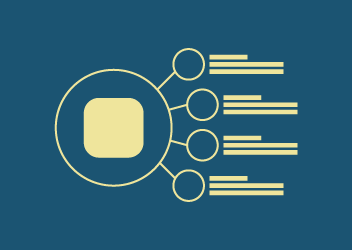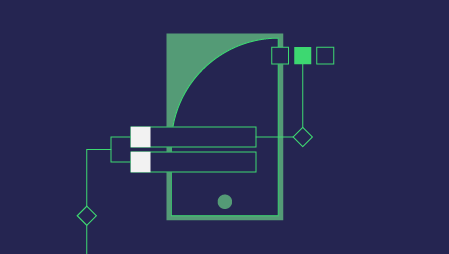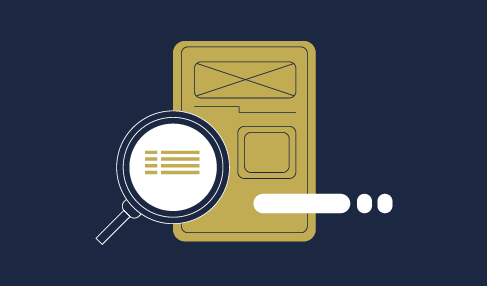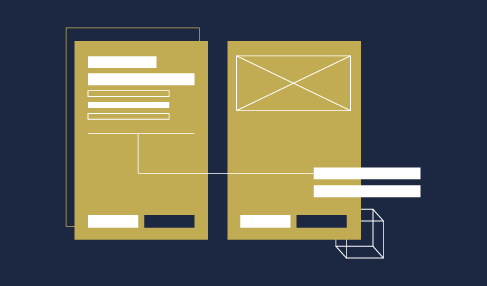Ever wanted to know how the apps you use every day are created? How an idea is turned from a sketch on a napkin into a fully functioning mobile app? Have an idea for an app and want to see if you can bring it to fruition? If so, you’re in the right place!
This page is going to walk you through the entire process of mobile app development from beginning to end.
It will be a high level view as the mobile app development process can be very complex. We cannot show you exactly how you can build an app from scratch on a single page. Instead, we are going to outline the process a typical app takes from that eureka moment when you have an idea to the satisfaction of seeing your app in an app store.
Key steps in mobile app development
There are usually 10 distinct steps in mobile app development. There can be more depending on the complexity of the app, but these 10 are the usual.
They are:
1. Affirming the idea
2. Performing market research
3. Wireframing
4. Choosing your technology
5. App development
6. Testing
7. User testing
8. Launching the beta
9. Launching the app
10. Post launch activities
Affirming the idea
Affirming the idea means making sure you know exactly what you want your app to do and what it should achieve. That includes defining the main objective of the app, it’s target audience, the app’s USP and the primary competition.
Once you have this information you can then scope out the estimated cost and timeline and either look for investment or fund it yourself. It costs anywhere between $150,000 to $200,000 to bring an app to market so be prepared!
Performing market research
Market research builds on your audience analysis and asks key questions that will either confirm or deny your stated goals. Perform this research at the earliest stage to prevent wasting time or money later on. You need to know if there is a market or appetite for the app you want to develop before you invest too much in an idea that will go nowhere.
You will want to know your target audience, their likes and dislikes, what they want from an app and what you can feasibly deliver within budget and timescale.
Market research is a detailed exercise that should involve asking more than your friends or work colleagues. It should include as wide an audience as possible to give you the clearest picture possible.
Wireframing
Wireframing is the process of building a mockup of your app. It can be as simple or as complex as you like as long as it provides a clear idea of what the app will do and what it will look like.

This is an incredibly important step in the mobile app development process. Like a blueprint for a building, you need to get everything right at this stage to prevent avoidable mistakes manifesting later.
Wireframing refers to a digital mockup but it doesn’t have to be actual wireframes. It could be a scale drawing, animation or a full scale working model of your app.
A wireframe should outline what the app looks like, the entire customer journey, the structure, frame, style and everything that a developer needs to know to build the app.
If you’re developing your own app, a wireframe shows you how it will work and demonstrate any shortcomings in the design. If you’re using a developer, a wireframe accurately defines how you want the app built and how it is supposed to work.
Choosing your technology
The technology you use to create your app depends on your skill level and whether you’re using an external developer or not.
You have several options here. You could go for native development for iOS and Android, use Javascript, use Rapid App Development (RAD) tools, an app creation tool, HTML 5 tool or something else. Each has its pros and cons and budgetary and skill requirements.
App development
The app development phase of the mobile app development process is often regarded as the easy part.

The hardest part of this is building your app development team, but if you’ve got a solid interview process in place, then you should be able to build a strong team.
If you’re not familiar with the hiring process, then check out this application developer interview questions guide by CollectiveRay.
Once your team is hired, development is usually in two phases, prototyping and development.
Prototyping takes the wireframe and creates a basic version of the app using your chosen technology. The prototype should be as detailed as possible and closely reflect the end product. The more work you do during prototyping, the less time and money will be wasted during development.
The development phase includes back end, front end and API coding and is usually a staged process. It should deliver a finished, fully-functioning app that is ready for testing.
Testing
Testing, or QA, (Quality Assurance) is another key stage of the mobile app development process. Like planning and prototyping, the more time you spend in testing, the less time and money is wasted later.
Even the best-designed app will have faults and won’t always work as you initially planned or imagined. It is during the testing phase that you will find this out. You will also likely come across bugs and unanticipated features you’ll need to fix.
Testing can include a range of tasks including document testing, functional testing, usability testing UI/UX testing and compatibility testing. Some apps will also require performance, security and certificate testing too. Each is an independent phase and should be documented accordingly.
Certificate testing is important if you’re planning to release your app to the Google Play Store or App Store. Both have stringent standards that need to be adhered to in order to be listed.
User testing
While user testing is part of the testing phase, it’s the next stage of the mobile app development process. Once you have tested in house and eliminated as many bugs and issues as possible, it’s time to test it in the wild.
Try as you might to break your app during QA, you can be sure that a member of the public will be able to do it in seconds!
User testing should include as many users as possible. The more people that test the app, the more chance you have of catching issues early. You can use feedback to refine the design or functionality of your app before beta.
Launching the beta
It isn’t always possible to launch a beta of an app, but if you can, you should. It’s a chance to have more people test your app and for early adopters to provide feedback. As early adopters tend to be fairly knowledgeable about technology, they can act as a more qualified round of user testing.
Beta testing is a valuable part of the mobile app development process and should not be overlooked if at all possible. Use the feedback to refine the app before launch and make sure your testers know you’re doing it as it will help with marketing and word of mouth.
Launching the app
Launching the app is the penultimate phase of mobile app development and usually the easiest. If you have performed the previous steps adequately, you should be able to launch the app in the Google Play Store or Apple store or provide it to your users by another means.
The app stores have their own list of requirements that will include a technical review and certification. This can take a while so be prepared for a wait. Once approved, you can launch your app.
Post launch activities
Post launch activities include marketing, bug fixing, performance measurement and improvement. All are incredibly important in the success of a commercial app and will need to be given as much time and attention as the rest of the development process.
Marketing
Marketing your app includes using every channel at your disposal to get the word out about it. Use an app website, use social media, use reviews, use influencers, use paid ads, use SEO and use every marketing tool at your disposal to promote the app.
Create a series of videos showcasing the app, showing people how to use it and answer frequently asked questions. This will help reduce queries and promote your app on YouTube and other video sites.
Bug fixes
Bug fixing is inevitable. If you invested time into testing, you should have quashed the worst, but some always slip through. No matter how thorough your QA and user testing, there will always be an unexpected feature or bug to contend with that won’t appear until after launch.
Make sure to allocate time after launch to refine and fix. Make sure to advertise what you’re doing as responsive developers sell more apps!
Performance measurement
Performance measurement looks at sales, reviews and feedback. It should provide quantifiable measures of how successful the app is, what the most requested changes or features are, the most common complaints and anything else you want to know.
This measurement can be passive or more active. Passive measurement includes looking at sales and reviews. Active measurement can include surveys, targeted reviews and social media polls.
App improvement
App improvement takes the feedback from performance measurement to direct future updates of your app. Build those improvements where feasible to steadily improve the app and give the audience what they want.
Just remember to perform regression testing and full QA before releasing the updated version. Nobody wants to find unexpected features in an ‘improved’ version of an app!
An app that has a responsive developer will sell more. An app that is continually refined and improved will also sell more. An app that is launched and left to its own devices may sell well initially but will always fail to retain interest. That’s not something a developer or user wants to see.
That’s a high-level overview of the mobile app development process. There is, of course, a lot of detail missing from each of those sections but now you have a better idea of what’s involved, what you need to learn and how much it costs to develop the average app.
Good luck with your venture!





